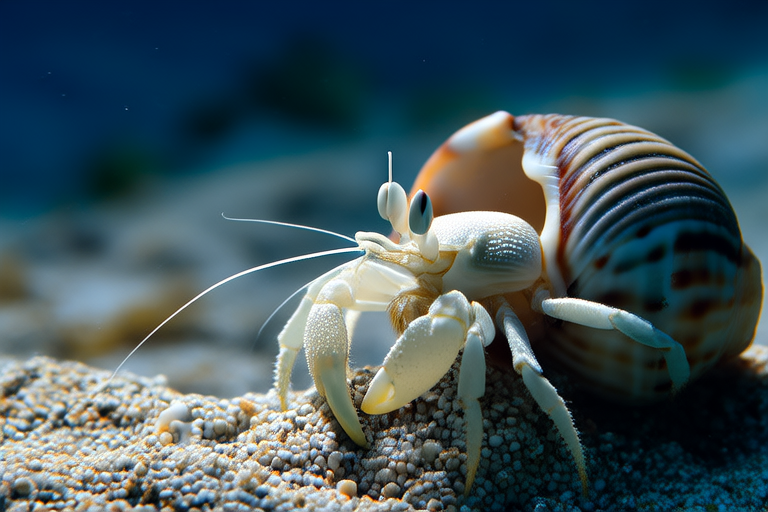The Fascinating World of Pea Crabs: Hidden Heroes of Marine Ecosystems
Pea crabs, tiny crustaceans that live within the gill chambers of bivalves, are a marvel of nature. Their unique life cycle, symbiotic relationships, and remarkable adaptations make them an intriguing subject for marine biologists. These minuscule creatures play a crucial role in marine ecosystems, and their study can provide valuable insights into the health of our oceans.
A Unique Life Cycle
The life cycle of pea crabs is as fascinating as it is complex. It begins when female pea crabs lay eggs inside the gill chambers of their host bivalves. The larvae hatch and swim freely in the water column before settling on another bivalve. Once they find a suitable host, they undergo metamorphosis, transforming into their adult form. This process ensures that pea crabs remain protected within the safety of their bivalve homes, allowing them to thrive in various marine environments.
Symbiotic Relationships
Pea crabs have evolved a remarkable symbiotic relationship with their bivalve hosts. While living inside the gill chambers of their hosts, pea crabs feed on plankton and detritus filtered by the bivalves. In return, they help clean the bivalves’ gills, enhancing the host’s respiratory efficiency. This mutualistic relationship benefits both parties, enabling them to coexist harmoniously in their underwater world.
Adaptations for Survival
Pea crabs have developed several adaptations to survive within their bivalve hosts. Their flattened bodies allow them to maneuver easily within the confined spaces of the gill chambers. Additionally, they possess specialized appendages called maxillipeds, which enable them to filter food particles from the water flowing through the host’s gills. These adaptations not only ensure their survival but also contribute to the overall health of their bivalve hosts.
Diet and Size
Pea crabs are opportunistic feeders, consuming a wide variety of food sources. Their diet primarily consists of plankton, detritus, and other small organisms that enter the gill chambers of their hosts. Despite their name, pea crabs are much smaller than peas, typically measuring between 5 to 15 millimeters in length. However, some species can grow up to 30 millimeters, making them relatively large compared to other crustaceans of similar habitats.
Geographical Distribution
Pea crabs are distributed across the globe, with species inhabiting both temperate and tropical waters. They can be found in shallow coastal areas, estuaries, and even deep-sea environments. Some species are highly specialized and can only be found in specific regions, while others have a broader range, thriving in diverse marine ecosystems. Their adaptability and ability to coexist with various bivalve species make pea crabs a common sight in many parts of the world.
Role in Marine Ecosystems
Pea crabs play a vital role in marine ecosystems, contributing to the balance of their habitats. By feeding on plankton and detritus, they help control the population of these organisms, preventing overgrowth and maintaining the health of their bivalve hosts. Additionally, their presence can serve as an indicator of the overall health of the ecosystem, providing valuable information for marine biologists and conservationists.
Conservation Status
Despite their widespread distribution, pea crabs face threats from human activities such as pollution, habitat destruction, and overfishing. Many species of bivalves, which are essential to pea crabs’ survival, are declining due to environmental pressures. As a result, the conservation status of pea crabs remains uncertain, highlighting the need for further research and protection efforts to ensure their continued existence.
Recent Scientific Discoveries
Recent scientific discoveries have shed light on the unique behaviors and adaptations of pea crabs. Researchers have found that some species of pea crabs can produce sound waves to communicate with their hosts, ensuring they remain undisturbed within the gill chambers. Another exciting discovery involves the use of chemical signals by pea crabs to locate and settle on their preferred bivalve hosts. These findings deepen our understanding of pea crabs and their interactions with their environment, offering new opportunities for research and conservation.
The Importance of Studying Pea Crabs
Studying pea crabs is essential for understanding the intricate relationships within marine ecosystems. By examining their life cycles, symbiotic relationships, and adaptations, researchers can gain valuable insights into the health of our oceans. Furthermore, the conservation of pea crabs and their bivalve hosts can have far-reaching implications for the preservation of marine biodiversity. As we continue to explore the mysteries of the underwater world, pea crabs stand as hidden heroes, playing a critical role in the balance of marine ecosystems.
In conclusion, pea crabs are fascinating creatures with a unique life cycle, symbiotic relationships, and remarkable adaptations. Their role in marine ecosystems, conservation status, and recent scientific discoveries highlight the importance of studying these hidden heroes for the health of our oceans. By unraveling the mysteries of pea crabs, we can better understand the complexities of marine life and work towards preserving the delicate balance of our underwater world.
